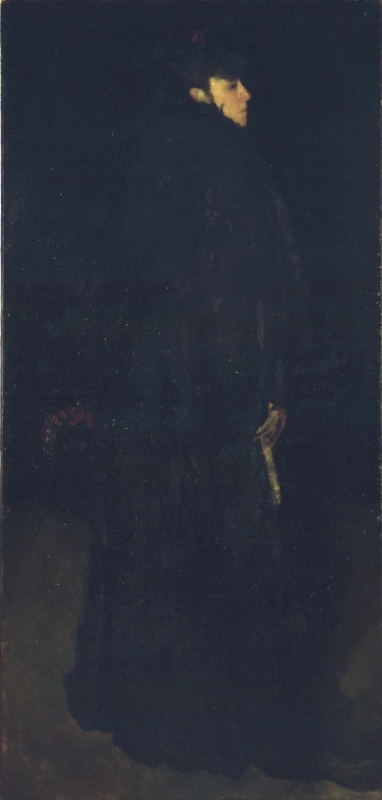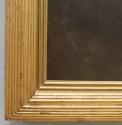Composition
Photographs in Glasgow University Library show it before completion. The robe appeared lighter and stood out strongly against the dark background at left, but the photographic process may have produced this effect. 1 The grey pattern, which has cracked a little, was probably originally much clearer. There was no big red butterfly, and the right hand, holding the fan, was concealed in the sleeve.
In June 1896, according to E. G. Kennedy, there were three full-lengths of Mrs Whibley in the Fitzroy Street studio, including 'one in black' and he added 'There was something to do to the hands of each.' 2
Technique
The paint has been applied fairly thinly with broad brushstrokes. However, the excessive use of thinners has caused poor paint film formation.
Conservation History
The painting has darkened. It is difficult to distinguish the darker areas of dress and background, although the varnish does not help in this respect, nor does the lead soap formation in Whistler's paint, a sign of deterioration in the paint. 3
Frame
It is in a Convex Portrait Whistler frame, with liner. 4
Notes:
1: GUL Whistler PH4/56/1 and 2. See University of Glasgow, University Collections at http://collections.gla.ac.uk. Dr Joyce H. Townsend, Chief Conservator, Tate Britain, comments on the old photograph: '[It] must have been taken using orthochromatic film, the only type then available. This is more sensitive to the infrared range than the panchromatic B&W film used in the mid- and later 20th century, and it required strong lighting. The resulting images are more akin to infrared images taken today, and they emphasise black pigments, alone or in admixture with white to make a grey tone. Thus, the patterned grey scarf or shawl that is difficult to ‘read’ today – a consequence of lead soap formation in Whistler’s paint ‒ is depicted very clearly in the earlier image.' (Record of examination, 2017).
2: Note dated 6 September 1903, with Whistler to E. G. Kennedy, [28 June 1896], GUW #09761.
3: Dr Joyce H. Townsend, Tate Britain, Report of examination, March 2017.
4: Dr S. L. Parkerson Day, Report on frames, 2017; see also Parkerson 2007 [more] .
Last updated: 22nd October 2020 by Margaret









